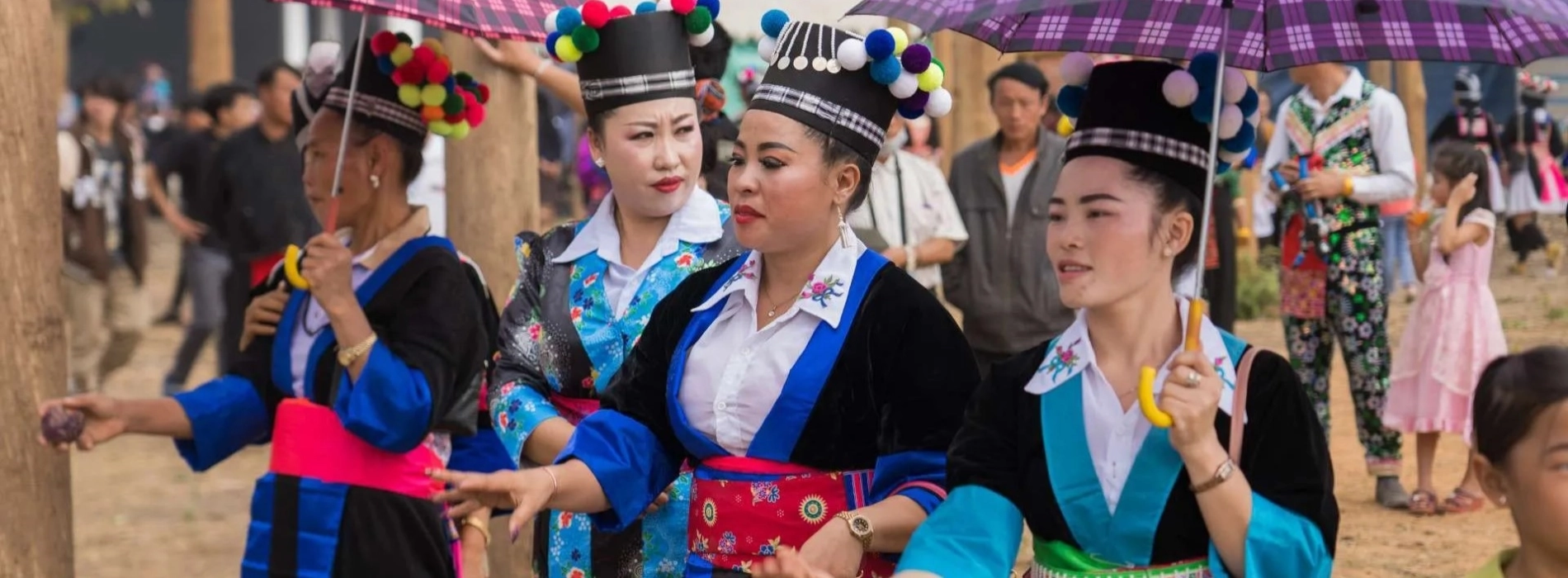
Bun Kin Chiang (also known as Bun Kin Chieng or Nu Pejao) is an annual festival in the Hmong community in Laos. This is an occasion for the Hmong people to rest and have fun after the harvest season ends. Bun Kin Chiang is celebrated from late December until after the Western New Year to welcome the new beginning.
It usually involves Hmong music, traditional ball games, dancing, and a beauty pageant. It would also be a great time to see men and women adorning themselves with colorful handmade garments with intricate headpieces and jewelry.

Hmong young men play games at the festival fair (Source: Ock Pop Tok)
The Hmong people are the third largest ethnic group in Laos, having a rich history and unique alphabets, dialects, and well-preserved customs and traditions. Hmong people in Laos originated in Southern China. In the late 18th century and early 19th century, some groups had migrated to the Northern Laos to escape persecution in their homeland.
There are three Hmong subgroups in Laos: Hmong Dao (White), Hmong Du (Blue), and Hmong Djua (Striped). They are distinguishable by their clothing. Modern Hmong people settled in different cities in Laos, mostly in Vientiane, Luang Prabang, Long Lan, and Xiangkhouang, leading to large-scale Bun Kin Chiang celebrations.

A Hmong girl in Ban Vang Ngern (Source: Ock Pop Tok)
The Hmong ethnic group's festival is warm and charming, combining modern times and ethnic cultures that are hard to experience in Thailand. Considered the Hmong New Year, Bun Kin Chiang represents unity and is a commitment among different Hmong sub-groups to gather and commemorate their ancestors.
Bun Kin Chiang is also meant to reflect on the past year’s production activities as well as to preserve and promote their beautiful traditions and culture. It is an occasion to show their respect to their forefathers, parents, and other important figures, and to meet with relatives, fostering unity and mutual respect.

Hmong people in traditional costume during festivals (Source: Ock Pop Tok)
The Hmong New Year includes 3 main stages.
During Hmong New Year ceremonial white paper is nailed on the columns of the house and a chicken is killed in the ancestors’ honor.

Lao Hmong people attend the festival in Luang Prabang (Source: Explore Laos)
Besides, the festival also requires a handful of in-house rituals. One of them is “Hu Plig” (Calling Spirit). This traditional ritual means calling home all of the wandering spirits of the household. Another one is “Txi Xwm Kab”. It is the ritual of honoring the God of Wealth and Riches, where a shrine is made and goods are offered so that the new year may bring wealth.
Suggestion for you: The elephant festival in the Land of a Million Elephants
The beauty pageant is considered a meaningful activity to honor the natural beauty of Hmong women. Besides, it has contributed much to promoting the local festival and attracting tourists’ attention.

Participants of a Hmong beauty contest in Vientiane (Source: VOV VN)
There are a wide variety of activities taking place during Bun Kin Chiang. Many traditional games can be listed like spinning top, crossbow shooting, stick pushing, and a Hmong pan-pipe competition.
Among those games, ball tossing (or pov pob) may be the most popular one. Playing pov pob is not only a handed-down custom but also a love ritual.
.jpg)
Hmong boys and girls play ball tossing (Source: Explore Laos)
Since traditional Hmong villages are small and people spend most of the year planting and harvesting rice, it is hard for young people to find a partner. Besides celebrating the end of the harvest and the start of a new year by giving thanks for what they have, the Hmong New Year is also a great time for people from smaller villages to come and have fun together. Thus, the Hmong New Year offers young people a chance to look for potential future husbands or wives.

A chance for young people to find their partners (Source: Explore Laos)
Visitors can enjoy many famous local specialties made from fresh materials such as mushrooms, noodles, glutinous rice, forest honey, and beef. All the dishes are considered among the best due to the renowned skillfulness of the local people.
These days, Hmong women wear colorful, flared dresses, while Hmong men dress more simply in indigo shirts and wide-legged black pants, with fabric belts adorned with patterns and colorful buttons sewn by their mothers and sisters. Tourists can be able to witness and capture vivid festival scenery and try on traditional Hmong costumes.

Hmong girls participate in Bun Kin Chiang (Source: Explore Laos)
Hmong people in Laos are warm and friendly, so whoever comes there can feel their enthusiasm and hospitality. That ensures travelers will have an unforgettable experience in their lives.
Bun Kin Chiang Festival has brought a lively and joyful atmosphere to both local people and tourists. Through this event, travelers can gain a deeper insight into the life and culture of Hmong ethnic groups. Ready to explore with Asia King Travel? Contact us to plan your travel!
Suggestion for you: Explore Laos' National Culture